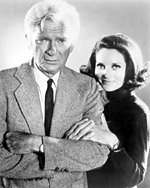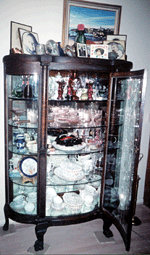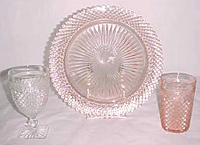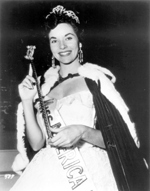|
The Celebrity Collector
Lee Meriwether Collects Depression Glass
in
the Miss America Style.
By Ken Hall
There's something poetic
about a former Miss America who becomes a collector of something in
the Miss America pattern. Such is the case with Lee Meriwether --
Miss America 1955 and an actor best known for her role on TV's
"Barnaby Jones," as Catwoman in the original "Batman" movie and in a
recurring role on the soap "All My Children." She has about 20
pieces of Depression Glass.
"I was browsing in this
interesting little antiques store in Howell, Michigan, where my
husband (the actor Marshall Borden) grew up," Meriwether said from
her home in Los Angeles. "A pink plate caught my eye, which I picked
up and studied before flipping it over. On the reverse side, there
was a sticker that said 'Miss America Depression.' I couldn't
imagine what in the world that could mean."
She asked the shopkeeper,
who explained that Meriwether was holding a piece of Depression
Glass in the Miss America pattern, characterized by a hobnail-type
geometric design. The Hocking Company introduced Miss America in
1933 and manufactured it in seven colors for five years. The pattern
has 36 pieces and is different from other patterns of the period.
All of Lee's pieces are pink.
For those unfamiliar with
or vague about Depression Glass (as Lee was that day in Michigan!),
a little explanation is in order. Depression Glass refers to colored
transparent glassware made in America from the early 1920s through
the end of World War II. It's so-named because the Great Depression
comprised the bulk of that era. But the glass was produced both
before and after Meriwether's Miss America pattern was one of many
styles made by a stream of companies, many of which fizzled out
during the Great Depression, never to return. That's probably why
Depression Glass died out -- no one made it after the war. But
during its heyday, it was enormously popular. Often, it was used as
a promotional giveaway at movie houses and in soap or cereal
boxes.
With the purchase of that
one pink plate, Lee was hooked. She had found a collectible that
spoke her name and was quite pretty, too. She studied up on
Depression Glass with her daughter Kyle, who soon began a collection
of Depression Glass teacups. They learned that the key to a
desirable piece of Depression Glass has as much to do with condition
as color, pattern and style.
"It's getting harder to
find pieces without any chips, cracks or marks," Lee lamented. "I
think that's why they're getting so expensive. There's a lot out
there, but so much of it is damaged. And any imperfections will ruin
the value." She added she finds most of what she buys at flea
markets, boutiques and antiques shops. "I'm a little leery of eBay,"
she added. "I like to touch what I buy."
Meriwether's collection
includes tumblers (picked up for her by her brother Don, who lives
in Lodi, Calif., and keeps an eye peeled for buys); a cake plate;
serving pieces; cream and sugar compote; cups and saucers; and a
candle-holder that can be turned upside down and used as a champagne
glass. Each piece is clear, pale pink. "I just love that color," she
said. "It's so light and pretty."
Lee offhandedly mentioned
she also has some pieces in the 'Thistle' pattern, but she wasn't
sure if they were even Depression Glass. A little research revealed
that they indeed are. Thistle was introduced in 1929 by
MacBeth-Evans, which eventually became part of Corning Glass Works.
It was produced for only two years, in four colors, with seven
pieces in the set. It had a floral design.
Meriwether's collection is
proudly displayed in an old curved glass hutch made of mahogany. She
bought the piece about 40 years ago while going door-to-door for the
March of Dimes. "I had Kyle in the stroller with me and I was just
going around the neighborhood, collecting money," she remembered,
"and this one woman had this lovely house with price tags on all the
furnishings."
Lee was astounded. So much
of what was in that house was so beautiful, and it was all for sale!
"The hutch is what really grabbed me, though," she said. "It has
five tiers of glass shelves and the wood is this wonderful, dark
mahogany. The lady said I could have it for $150. I told her to hold
it for me while I went and got the money. I also bought an adorable
old cash register for $15."
Meriwether figures she'll
be able to add to her glass collection when she goes on the road
starting Dec. 10, co-starring in the 20th Anniversary All-Star Tour
of the play "Nunsense," with Kaye Ballard, Georgia Engel, Mimi Hines
and Darlene Love. "We'll be playing eight shows a week for 22
weeks," she said. "Each week we'll be in a new city. I'm going to
get in as much antiquing as I can."
Lee Meriwether was born in
Los Angeles and spent her early years there and in Phoenix. As she
was about to enter the fifth grade, her father was transferred to
San Francisco and that's where she finished her education. At George
Washington High School (where singer Johnny Mathis was a classmate)
she got her first taste of acting and made the decision to pursue
dramatic arts.
At City College of San
Francisco, Meriwether majored in Theatre Arts and Radio/TV. On a
lark, a fraternity nominated her for the Miss San Francisco pageant
which, to her complete shock, she won. "I never would have entered
on my own," she said. She went on to win Miss California, but almost
didn't compete for Miss America at all when her father suddenly and
unexpectedly died.
"I felt as though my whole
world had dropped out from under me," she said, "but my mother
reminded me of how proud my father was that I had won the state
title and how eager he was to have me compete for the crown. Not to
mention the scholarships!" Meriwether credits her mother for being
an ongoing source of inspiration and support in her life, both
personally and professionally.
After her year's reign as
Miss America, Meriwether joined TV's "The Today Show" as the
program's first women's editor. She also studied acting under Lee
Strasburg and took lessons in dance, singing and fencing. Her first
dramatic TV role was in "The Philco Television Playhouse," with Mary
Astor. Then a movie part, in "The 4-D Man," starring Robert Lansing.
Stage work soon followed.
Her most memorable film
role is that of Catwoman in the original "Batman" movie. She also
played Andy Griffith's wife in "Angel in My Pocket" and Rock
Hudson's wife in "The Undefeated." In live theatre (her first love),
she has appeared in "Spoon River Anthology" (with Betty Garrett),
"Aesop in Central Park" (with Richard Dreyfuss) and "Ladies of
Hanover Towers" (with Carroll O'Connor).
Lee met her husband
Marshall in San Antonio in 1983, where the two were starring in a
production of "Angel Street." Over the next several years, they
found themselves working side by side frequently -- in "The Lion in
Winter" and "Alone Together." Along the way they fell in love and in
1986 they got married -- in San Francisco, while performing one of
Marshall's plays, "The Artful Lodgers."
Meriwether has two
daughters from a previous marriage: the aforementioned Kyle, who
made Lee a grandmother almost ten years ago when she gave birth to
Ryan Isabella Oldham in late 1993; and Lesley, a professional
stuntwoman who has doubled for stars such as Sigourney Weaver. She's
also in the just-released film "The League of Extraordinary
Gentlemen," starring Sean Connery.
Over the next several
months, Meriwether will be rehearsing and getting into shape for
what will be a grueling 22 weeks in "Nunsense." She will be
performing six days out of seven, with two performances on two of
those six days. The only day off is for travel from city to city. "I
knew all this going into the project," she said with a laugh. "I
said yes without a thought. I love acting that much."
Fans of Lee Meriwether may
write to the star at ABC Television, c/o "All My Children," 320 West
66th Street, New York, NY 10023.
2003
|

Lee
co-starred with Buddy Ebsen in the hit TV series "Barnaby Jones."
Ebsen recently died at age 95.

Lee
bought this antique display cabinet while going door-to-door for the
March of Dimes years ago.

The
Miss America pattern is
characterized by a hobnail-type geometric
design.

Lee
would never have found fame if friends at college hadn't nominated
her for Miss San Francisco.

Lee
served as Miss San Francisco and Miss California before being
crowned Miss AmerIca in 1955.
|